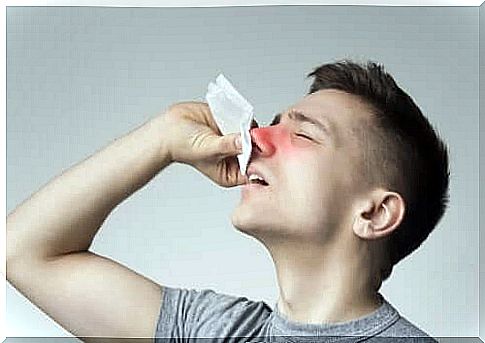Nasal Polyps: Symptoms, Causes And Treatment

Nasal polyps are soft, sac-like masses that grow in the lining of the nose or sinuses. It is a condition that occurs most often in adults and only very rarely in children under the age of 10.
It is estimated that between 1 and 5% of the population suffers from nasal polyps. They affect men and women more or less equally, although the incidence is slightly higher in men. People between the ages of 30 and 40 are usually the most affected.
This disease is considered a variant of sinusitis, more precisely of polypoid sinusitis. The size of nasal polyps can vary a lot: they can be very small or reach large in size. In many cases they are not a major problem, but in others they can cause obstruction of the nasal airways.
What are nasal polyps?

Nasal polyps are whitish-looking, soft, and often tear-shaped formations. The appearance is similar to that of a peeled and seedless grape. They form inside the nasal cavities or paranasal sinuses. They can be single or multiple.
They are considered benign lesions. Unlike polyps that appear in the bladder or colon, nasal polyps are not malignant tumors and present only a minimal risk of malignancy. They are generally caused by chronic inflammation and are often associated with asthma, immune disorders, allergies, etc.
These formations appear as a result of the hypertrophy of the natural mucosa present in the nasal cavities or in the paranasal sinuses. In these cases, the mucous membrane grows and fills with a thick fluid. Gradually, this accumulation is forming polyps. This condition is called nasal polyposis.
Causes
The causes of nasal polyposis are the subject of some controversy. Traditionally this disorder was considered to be associated with some type of allergy, but there are also cases where this association is not present. The evolution of this disease is also not fully known.
Some data indicate that chemical markers of the mucosa, as well as the responses of the immune system, are different between those with a tendency to develop nasal polyps and those who do not. This suggests that some genetic mutations could be involved in this process.
In each case, a list of conditions has been drawn up that act as risk factors for this disorder. The list includes:
- Asthma.
- Allergic mycotic sinusitis.
- Cystic fibrosis.
- Sensitivity to aspirin.
- Vitamin D deficiency
- Syndrome Churg-Strauss (eosinophilic granulomatosis with polyangiitis).
In some cases, polyps form during an infectious process in the nose and then disappear when the infection clears. They can also form in the presence of a foreign body in the nose.
Symptoms of nasal polyps

When polyps are small, they usually don’t cause any symptoms and therefore often go unnoticed. As they increase in size, they become noticeable and can cause discomfort or cause nasal airway obstruction.
Not infrequently, large polyps can cause a sinus infection, a common symptom of polyposis. Nasal congestion, some degree of loss of smell and taste, runny nose, headache, pain in the affected area and cold symptoms are also common.
In some cases, people with nasal polyps are forced to breathe through the mouth. This happens because the nasal passage is blocked to a greater or lesser extent. In some cases the polyp can even become visible in the nostrils.
Treatment
The most effective way to treat nasal polyps is surgical extraction. However, before resorting to surgery, people will normally rely on other therapies to treat them, especially if the polyps are not too large.
Treatment usually begins with the administration of corticosteroids, by means of nebulizations in the nasal cavities or orally. Corticosteroids tend to produce side effects, so close monitoring is required.
Antihistamines and antibiotics are also commonly used. If the polyp is very large and causes some degree of obstruction, it is advisable to undergo surgical removal. However, it is shown that polyps can re-form even after such a procedure.









